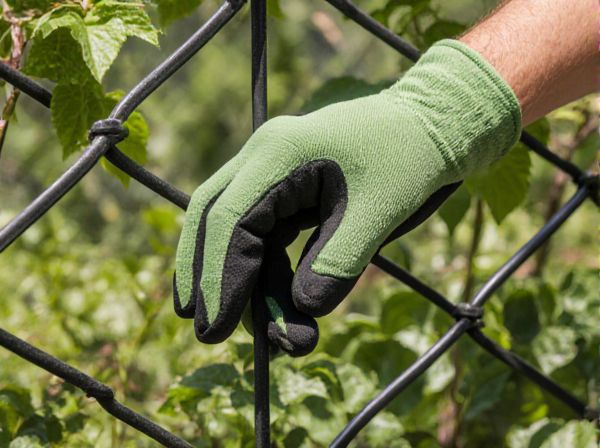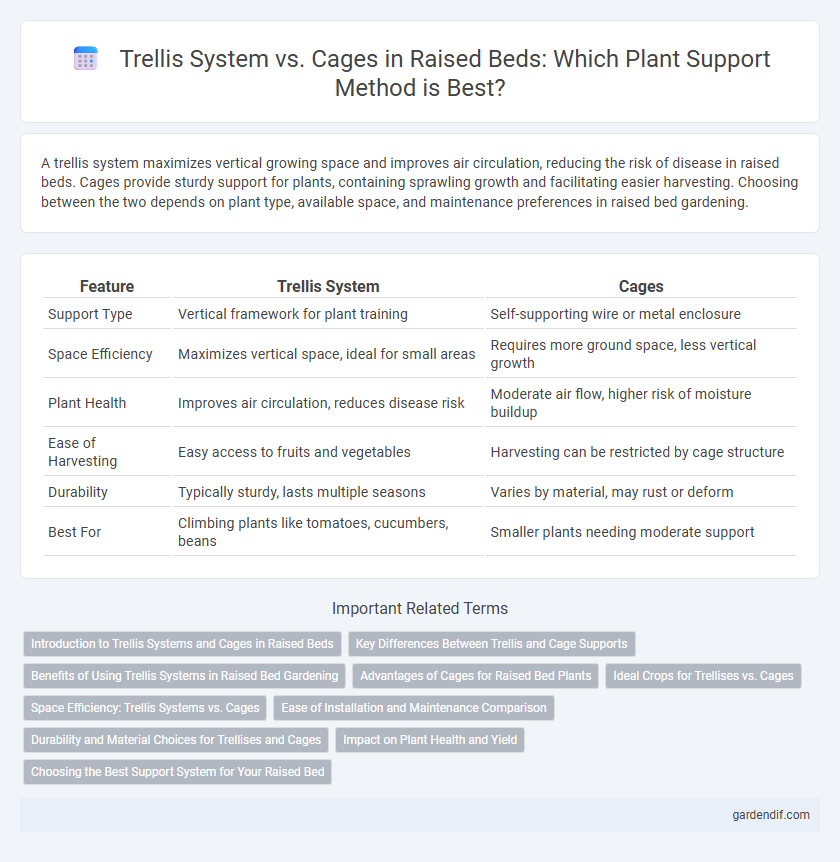
Trellis System vs Cages Illustration
A trellis system maximizes vertical growing space and improves air circulation, reducing the risk of disease in raised beds. Cages provide sturdy support for plants, containing sprawling growth and facilitating easier harvesting. Choosing between the two depends on plant type, available space, and maintenance preferences in raised bed gardening.
Table of Comparison
| Feature | Trellis System | Cages |
|---|---|---|
| Support Type | Vertical framework for plant training | Self-supporting wire or metal enclosure |
| Space Efficiency | Maximizes vertical space, ideal for small areas | Requires more ground space, less vertical growth |
| Plant Health | Improves air circulation, reduces disease risk | Moderate air flow, higher risk of moisture buildup |
| Ease of Harvesting | Easy access to fruits and vegetables | Harvesting can be restricted by cage structure |
| Durability | Typically sturdy, lasts multiple seasons | Varies by material, may rust or deform |
| Best For | Climbing plants like tomatoes, cucumbers, beans | Smaller plants needing moderate support |
Introduction to Trellis Systems and Cages in Raised Beds
Trellis systems in raised beds provide vertical support for climbing plants, maximizing space and promoting better air circulation which reduces disease risk. Cages, commonly used for tomatoes and peppers, offer sturdy individual support to keep plants upright and prevent fruit damage. Both trellises and cages optimize plant growth by improving sunlight exposure and ease of harvesting within compact raised bed gardens.
Key Differences Between Trellis and Cage Supports
Trellis systems provide vertical support by guiding plants like tomatoes and cucumbers upward, optimizing space and maximizing air circulation in raised beds. Cages encircle plants with a sturdy frame, preventing branches from sprawling and supporting fruit-laden stems, ideal for bushier growth. Key differences include trellises promoting vertical growth and airflow, while cages offer compact, surround support for plant stability and ease of harvest.
Benefits of Using Trellis Systems in Raised Bed Gardening
Trellis systems in raised bed gardening maximize vertical growing space, improving air circulation and reducing disease risk for plants like tomatoes, cucumbers, and beans. They enhance sunlight exposure and make harvesting easier by keeping fruits off the soil, which also helps prevent rot and pest infestation. Compared to cages, trellises allow for better plant management and higher crop yields in compact gardening environments.
Advantages of Cages for Raised Bed Plants
Cages provide superior vertical support for climbing plants in raised beds, maximizing space efficiency and improving air circulation around the foliage to reduce disease risk. Their sturdy design minimizes plant damage and allows for easier harvesting compared to trellis systems, which may require more complex installation. Cages are particularly effective for heavy fruit-bearing plants such as tomatoes, offering enhanced stability and promoting healthier growth.
Ideal Crops for Trellises vs. Cages
Trellis systems are ideal for vertical growers like tomatoes, cucumbers, peas, and beans, providing support that enhances air circulation and sun exposure, which reduces disease risk. In contrast, cages work best for bushier plants such as indeterminate tomatoes, peppers, and small eggplants, offering containment without excessive vertical growth. Choosing between trellises and cages depends on crop growth habits and space efficiency in raised beds.
Space Efficiency: Trellis Systems vs. Cages
Trellis systems maximize vertical space in raised beds, allowing plants like tomatoes, cucumbers, and beans to grow upward and reduce ground footprint. Cages offer limited vertical growth and require more horizontal space, potentially overcrowding raised beds and reducing airflow. Utilizing trellises enhances plant density and optimizes sunlight exposure, making them more space-efficient compared to cages in small gardening areas.
Ease of Installation and Maintenance Comparison
Trellis systems for raised beds offer straightforward installation, typically requiring simple stakes and netting, which can be adjusted or removed easily for maintenance. Cage systems often involve heavier, bulkier structures that must be securely anchored, making setup more time-consuming and demanding periodic checks for stability. Maintenance is generally simpler with trellises due to better access to plants and less obstruction, whereas cages can restrict mobility and complicate pruning or harvesting.
Durability and Material Choices for Trellises and Cages
Trellis systems for raised beds often use materials like cedar, metal, or PVC, providing superior durability and resistance to weather compared to traditional wire cages that commonly rust or degrade over time. Metal trellises, particularly those coated with rust-resistant finishes, ensure long-term support for climbing plants, while cages made from galvanized steel or plastic offer varying levels of sturdiness but may require more frequent replacement. Choosing rot-resistant wood or powder-coated steel trellises enhances longevity and structural integrity, making them a sustainable option for garden maintenance.
Impact on Plant Health and Yield
A trellis system promotes vertical growth, improving air circulation and reducing fungal diseases, which enhances plant health and increases yield in raised beds. Cages provide support by containing sprawling plants, minimizing physical damage but can limit airflow and light penetration, potentially reducing overall productivity. Choosing a trellis over cages in raised beds often results in healthier plants with higher fruit quality and quantity due to better exposure to sunlight and airflow.
Choosing the Best Support System for Your Raised Bed
Trellis systems provide vertical growth support ideal for climbing plants like tomatoes and cucumbers, maximizing space in raised beds. Cages offer sturdy, surrounding protection that keeps plants upright and contained, preventing sprawling and damage. Selecting the best support system depends on the plant type, growth habit, and available space within your raised bed for optimal yield and maintenance.
Trellis System vs Cages Infographic

 gardendif.com
gardendif.com